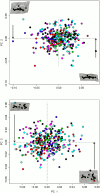Rapid Morphological Change in the Masticatory Structures of an Important Ecosystem Service Provider
- PMID: 26061880
- PMCID: PMC4465031
- DOI: 10.1371/journal.pone.0127218
Rapid Morphological Change in the Masticatory Structures of an Important Ecosystem Service Provider
Abstract
Humans have altered the biotic and abiotic environmental conditions of most organisms. In some cases, such as intensive agriculture, an organism's entire ecosystem is converted to novel conditions. Thus, it is striking that some species continue to thrive under such conditions. The prairie deer mouse (Peromyscus maniculatus bairdii) is an example of such an organism, and so we sought to understand what role evolutionary adaptation played in the success of this species, with particular interest in adaptations to novel foods. In order to understand the evolutionary history of this species' masticatory structures, we examined the maxilla, zygomatic plate, and mandible of historic specimens collected prior to 1910 to specimens collected in 2012 and 2013. We found that mandibles, zygomatic plates, and maxilla have all changed significantly since 1910, and that morphological development has shifted significantly. We present compelling evidence that these differences are due to natural selection as a response to a novel and ubiquitous food source, waste grain (corn, Zea mays and soybean, Glycine max).
Conflict of interest statement
Figures







References
-
- Berry R. J. (1964) The evolution of an island population of the house mouse. Evolution 18: 468–483.
-
- Williams C. K. and Moore R. J.. (1989) Phenotypic adaptation and natural selection in the wild rabbit, Oryctolagus cuniculus, in Australia. J Anim Ecol 58: 495–507.
-
- Pergams O. R. and Ashley M. V.. (1999) Rapid morphological change in Channel Island deer mice. Evolution 53: 1573–1581. - PubMed
-
- Reznick D. N. and Ghalambor C. K.. (2001) The population ecology of contemporary adaptations: what empirical studies reveal about the conditions that promote adaptive evolution. Genetica 112: 183–198. - PubMed
Publication types
MeSH terms
LinkOut - more resources
Full Text Sources
Other Literature Sources

